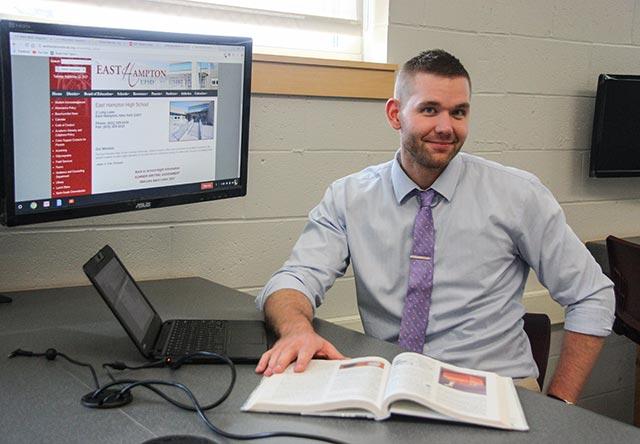Digital Age Library Is ‘Future Ready’

Michael Buquicchio is not called a librarian because East Hampton High School’s library is not called a library anymore. It is now known as the media center, and Mr. Buquicchio is the school’s media specialist. This more contemporary title is, in fact, fitting for someone only 10 years older than the current class of seniors, having graduated from East Hampton in 2007. It is even more appropriate given that Mr. Buquicchio recently spearheaded a renovation of the school’s media center, helping to modernize it and bring it up to speed — full-throttle internet speed, that is.Over the summer, the center was transformed, moving even further away from simply housing tomes — “We still have books!” Mr. Buquicchio stressed — to and toward connecting learners to 21st-century skills such as critical thinking, communication, creativity, and collaboration. In other words, instead of being an archive, the school library, like so many around the world, has become something known as a “learning commons.” Today’s digital world has even changed the focus of curriculums in schools, which are moving from fact-based to inquiry-based learning. The model of one-way communication from teacher to students has become an anachronism. In fact, last year, East Hampton was one of 650 schools nationwide selected to be an Advanced Placement Capstone school, an offshoot of A.P. that focuses on collaborative teamwork and communication skills through research, with the goal of cultivating scholars who learn to make evidence-based decisions. All Capstone classes culminate in oral, written, and digital presentations in front of an audience.It is hardly surprising then, that the school library has transitioned from a place to merely check out books to a mixed-use space for research, study, collaboration, global connection, and more — with librarians embodying the all-important connection between resources and students. For a 21st-century librarian, it seems there is a whole lot more to the job than stamping due dates.The Robin Hood Foundation, a charitable organization that attempts to alleviate problems caused by poverty in New York City, recognized the need for school libraries to evolve as early as 2004 when it began a library initiative, aimed at redesigning conventional libraries in underserved New York City public schools into more versatile learning centers of the future. To date the initiative has reconfigured over 60 inner city school libraries. While a graduate student at Queens College, Mr. Buquicchio worked in a Robin Hood library in Far Rockaway. He returned to his alma mater four years ago and recently became tenured. Although he said it was immediately apparent that the old space needed a 21st-century face-lift, it was not until East Hampton officially became a “one-to-one school” (one Chromebook per student) last year that it became a priority.“As technology advances, schools change,” Mr. Buquicchio said. The technology space within the old high school library, he explained, consisted of a long counter with 26 individual desktop computer stations. However, with every student in possession of a laptop, those desktops became obsolete. It was then that the district’s school board signed on to an official renovation. First, Mr. Buquicchio joined an organization called Future Ready Librarians, whose purpose is to better equip this new age of library gatekeepers to support teachers and students in their transition to a digital learning environment.Last winter, Mr. Buquicchio and a team of administrators enlisted the help of East Hampton High School students enrolled in a design and drawing class. Using a modeling software program, they created 3-D blueprints of their version of a state-of-the-art learning space designed to facilitate the way students consume and digest information in today’s world. The team discovered that one feature stood out as a priority: the need for tables around which groups of pupils could work in Socratic circles rather than individual workstations. “We needed to facilitate a space where students could easily connect and collaborate, and where nothing is too permanent, so that everything and anything could be quickly reconfigured to meet the changing needs of students and their projects,” he explained. Robert Hayman, the school’s director of technology, visited the Manhattan offices of a manufacturing company that specializes in office furniture and technology products for schools and universities and invited them to brainstorm for the East Hampton project. The company offered an estimate of $100,000 to furnish the space, which Mr. Buquicchio described as “multiples of our budget.”Ironically, in looking for solutions to transform an outdated library into an innovative space, old, unused materials provided the team with answers.“Repurpose became the word of this project,” Mr. Buquicchio said. The school’s head of maintenance, Reno Salsedo, took defunct countertops from an adjoining boardroom and made seven high tables, each finished with wooden edging repurposed from the old computer workstations. Old carpeting was ripped up and replaced by tiles found in storage. Discarded room partitions were cleaned up and repurposed as dividers between the technology lounge and the still-thriving printed books area. The only items purchased, said Mr. Buquicchio, were two large-screen monitors for each table, compatible with students’ laptops to facilitate their presentations. “And the chairs around the table,” he said, adding “though the wheels on them were found in storage.” Mr. Buquicchio said that several staffers pitched in with manual labor. Even the district’s superintendent, Richard Burns, and the assistant superintendent, Robert Tymann, rolled up their sleeves, helping to rip out carpet and do whatever was necessary.Other upgrades included wireless printers in the media center, with the entire school connected to a program called Paper Cut, which tracks each student’s paper footprint. As for the future, he is aware that constantly evolving technology will render even the revamped media center outdated before long. “It’s impossible to be future-proof,” he said. “But we are future-ready.”
